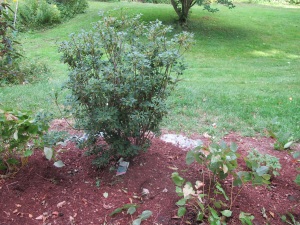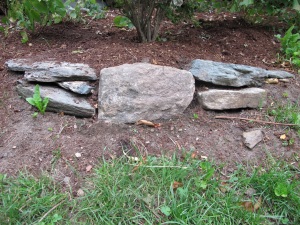Planting Trees
Except when the ground is frozen, you can plant trees and shrubs pretty much anytime. Some experts recommend planting in the fall when trees are less likely to suffer from hot weather and dry soil as autumn is generally cool and rainy. Others suggest planting in spring so the tree can get established before our harsh winter. I say, plant when you have the time and the desire. Then take care of the tree, and it will be fine.
This spring I planted a kousa dogwood (Cornus kousa) to replace a winter-killed mountain laurel. The dogwood is hardy to climatic Zone 5, meaning it will survive temperatures of 20 below zero, and I live in a Zone 4. Most winters we see minus 25. But I have it in a protected spot near the house, and I think it should survive. I’ll probably wrap in burlap its first winter. Of course, I am an incurable optimist – and I have always wanted a kousa dogwood, so I am willing to take a risk. That mountain laurel that died last winter gave me nearly 20 years of blooms and joy, and if the kousa dogwood does the same, I’ll consider myself very lucky.
One key to its survival, I think, is to get the roots to be well established by winter. And part of that is providing adequate water in its first year. So at least once a week I water it deeply. Now, in the heat of August, I water it twice a week. I have mulched the roots with bark mulch to keep the soil from drying out, and to keep the roots warmer this winter.
This summer I planted a shrub in memory of my sister, Ruth Anne Mitchell, who passed away 6 years ago. A friend told me Ruth Anne loved the redvein enkianthus (Enkianthus campanulatus), so I got one. I’d seen a nice specimen growing in the ground at E.C. Brown Nursery in Thetford, VT and was able to get a four-foot tall enkianthus from them. Since I had never noticed one before, I depended on my woody plant bible – Michael Dirr’s Manual of Woody Landscape Plants to tell me how to plant it.
Dirr’s book has a page or more on every species of plant that grows in America, and is spot-on with its advice. In this case, it said the shrub needs acidic soil, like rhododendrons. So I mixed 2 to 3 cups of garden sulfur into the soil that went into planting hole, along with some peat moss. And I put down a layer of peat moss on the soil surface after planting and covered it with bark mulch.
The enkinathus is hardy to Zone 4, and I can’t wait to see it bloom next June. It should be loaded with creamy yellow blossoms with red veins. The fragrance, according to Dirr, is somewhat unpleasant. Huh. But he says it should have brilliant fall color.
I planted the enkianthus on a hillside, which is always problematical. One must plant trees and shrubs on flat places because they come with a rootball that must be in the ground and the tree must be vertical, not tipping. Perennial flowers are easier: they have smaller rootballs so they require a smaller flat place. And they will straighten themselves up to vertical if planted on a slope.
My remedy for the hillside planting is to dig into the hillside above the tree and to build up the hillside on the downhill side of it. For a shrub with a 16-inch rootball I created a 48-inch flat space. Roots do better if you dig a wide hole – three times the width of the rootball is standard. Then, after placing the tree in the hole, you refill the hole with the soil that you dug out. Why? Because soil in most places is hard-packed and dense. Digging out soil and replacing it creates a nice zone of fluffy soil for the roots to start out in.
Some gardeners think it is good to add compost and fertilizer in the hole. While that is a good plan for a perennial flower, it is not for a tree or shrub. Think of a tree as a wine glass sitting on a dinner plate. The glass is the tree, the root system in the plate. The tree must send roots out far from the trunk, and if you pack the planting hole with compost and fertilizer, the roots will not be inclined to spread out to the un-amended soil.
I decided in this case to build a little stone retaining wall to hold the soil from washing downhill in times of heavy rain. I didn’t do much – I just found seven flat stones and arranged them in two layers on the downhill side of the planting. I didn’t dig a trench and put crushed stone in it as a base, as I would have if the wall were bigger. This was just a 15-minute job. The stones sat on well packed, unexcavated soil and should not move.
If I were to build or buy a new house (though I don’t plan to), the first landscaping task I would tackle would be to choose trees and shrubs and get them in the ground. They take years to reach their peak beauty, and not every tree planted survives. But I keep planting woody plants now, 40 years after I bought my place. I just wish I had more land so I could try everything.
Henry is a gardening consultant and the author or 4 gardening books. His website is www.Gardening-Guy.com.




